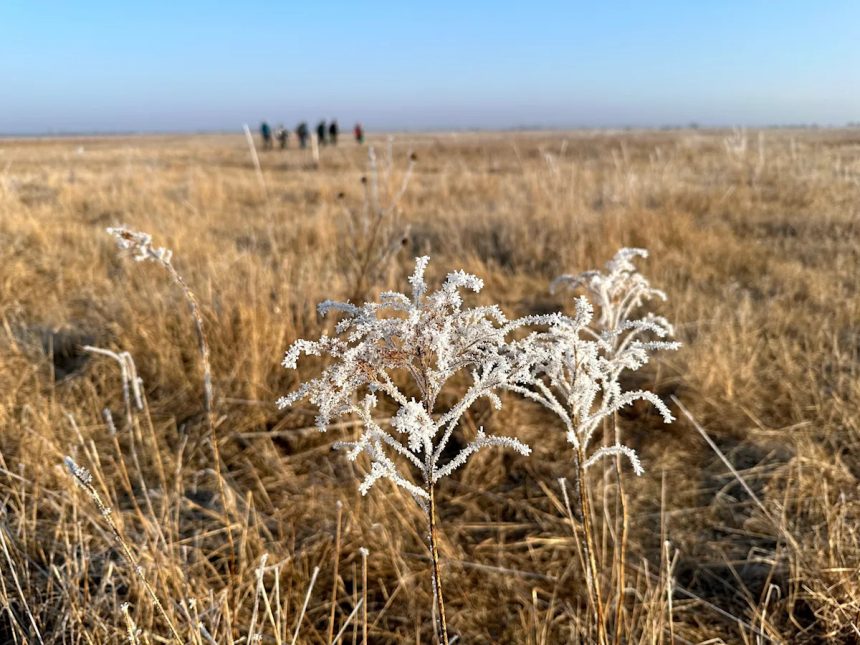The National Weather Service in Cleveland has issued a frost advisory across most of Northern Ohio as temperatures could drop as low as 32 degrees from Thursday night, Oct. 9, to Friday morning, Oct. 10. And the NWS office in Wilmington, which covers most of Central and Southwestern Ohio, says frost is possible in its region with temperatures falling into the mid-30s.
And with frost looming, and winter not too far away, you may want to take some steps to protect your house, yard and pets from the freezing weather.
Here’s what you can do.
National Weather Service in Cleveland issues frost advisory
The NWS has issued a frost advisory from 1 a.m. to 9 a.m. Friday, Oct. 10 across most of Northern Ohio, in these counties. The list includes Stark (Canton) and Summit (Akron) Counties and stretches as far south as Knox County northeast of Columbus:
Frost-covered plants stand in the foreground as people walk out after viewing greater prairie chickens at Buena Vista Wildlife Area in Wisconsin.
How to protect your outdoor and potted plants against the frost
Sometimes, an early frost is a freak incident, and there’s plenty of time in the growing season ahead, according to the Farmer’s Almanac. Some vegetables can tolerate a light frost, but many won’t. So, if your garden is still producing and you want to protect your crop, there are a few steps you can take.
The primary way to protect plants from frost is to cover them with a blanket or row cover, according to the almanac. Row covers can be found at garden stores in varying weights and thicknesses. Bedsheets, drop cloths and medium-weight fabrics are also good to use. Do not use plastic.
Drape the covers loosely over the plant to allow for air circulation, and don’t allow the fabric to touch the plant. Cover plants in the early evening, when the winds die down, and remove them the next morning when the temperatures begin to rise, per the almanac.

Frost will kill a tender annual plant like a zinnia.
Other suggestions to protect plants from frost include:
-
Mulch low plantings: Plants close to the ground can be covered with mulch or straw to protect them until the danger of frost has passed.
-
Water everything: Moist soil holds more heat than dry soil, per the almanac. It also keeps the air above it about 5 degrees warmer.
-
Build cold frames: Cold frames, bottomless boxes placed over plants to protect from frost, can be temporary or permanent structures in the garden.
-
Protect root vegetables: In milder areas, root crops can be left in the ground. Put mulch over them to protect them from the frost. In colder regions, or if the ground is likely to freeze solid, dig them up and store them in a cool, dry area.
If you have potted plants or container gardens, move them indoors, suggests Better Homes & Gardens. Moving them to an unheated location, such as a shed or garage, will provide enough protection against early frosts. But if the weather is calling for a freeze, move the plants indoors, where it’s warm.

Children and their dog play in the snow in Dayton, Kentucky, as Winter Storm Blair makes it way through Greater Cincinnati on Sunday, Jan. 5, 2025.
Protect your dog from the cold
If you have an outdoor dog, you may consider bringing them inside as it gets colder.
But that depends on the breed, Dr. Jennifer Coates writes for PetMD. Some dogs, such as Siberian huskies, Newfoundlands, and Samoyeds, originate in northern climates and are more tolerant of the cold with their thick, double-layered coats of fur. Others, like chihuahuas, Yorkies and Italian greyhounds, shouldn’t spend longer than 10 to 15 minutes outside when the weather is below freezing.
How cold is too cold for dogs? It depends. When to bring them inside, signs of frostbite
Protect your plumbing from freezing
And colder weather brings the danger of your outdoor faucets freezing, possible causing pipes to burst or leak. But you can take steps to protect your plumbing.
The Spruce, a website that offers tips from home decor to gardens and home improvement, advises you disconnect any hoses, shut off the water supply from inside the house and briefly open the spigot to drain the water line. Then you can install an insulating cover over the faucet.
What is a frost advisory?
According to the NWS, a frost advisory means that areas of frost are expected or occurring, posing a threat to sensitive vegetation.
A frost advisory is the lowest warning level in the set that includes a freeze watch and freeze warning.
A freeze watch is issued when there is a potential for significant, widespread freezing temperatures. They are typically issued in the fall through the end of the growing season, and in spring until the growing season begins.
Freeze warnings are issued when temperatures are forecasted to go below 32 degrees for a long period of time, killing most crops and household plants.
This article originally appeared on Akron Beacon Journal: Frost, freezing temperatures to hit Ohio. See full weather forecast









